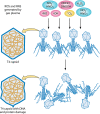An Overview of Diverse Strategies To Inactivate Enterobacteriaceae-Targeting Bacteriophages
- PMID: 36651738
- PMCID: PMC10729933
- DOI: 10.1128/ecosalplus.esp-0019-2022
An Overview of Diverse Strategies To Inactivate Enterobacteriaceae-Targeting Bacteriophages
Abstract
Bacteriophages are viruses that infect bacteria and thus threaten industrial processes relying on the production executed by bacterial cells. Industries bear huge economic losses due to such recurring and resilient infections. Depending on the specificity of the process, there is a need for appropriate methods of bacteriophage inactivation, with an emphasis on being inexpensive and high efficiency. In this review, we summarize the reports on antiphagents, i.e., antibacteriophage agents on inactivation of bacteriophages. We focused on bacteriophages targeting the representatives of the Enterobacteriaceae family, as its representative, Escherichia coli, is most commonly used in the bio-industry. The review is divided into sections dealing with bacteriophage inactivation by physical factors, chemical factors, and nanotechnology-based solutions.
Keywords: Enterobacteriaceae; antiphagents; bacteriophages; bionanotechnology; inactivation.
Figures





Similar articles
-
Bacteriophages of Soft Rot Enterobacteriaceae-a minireview.FEMS Microbiol Lett. 2016 Jan;363(2):fnv230. doi: 10.1093/femsle/fnv230. Epub 2015 Nov 30. FEMS Microbiol Lett. 2016. PMID: 26626879 Review.
-
Isolation and characterization of Enterobacteriaceae species infesting post-harvest strawberries and their biological control using bacteriophages.Appl Microbiol Biotechnol. 2016 Oct;100(19):8593-606. doi: 10.1007/s00253-016-7651-0. Epub 2016 Jun 29. Appl Microbiol Biotechnol. 2016. PMID: 27357225
-
The Effect of Zero-Valent Iron Nanoparticles (nZVI) on Bacteriophages.Viruses. 2022 Apr 22;14(5):867. doi: 10.3390/v14050867. Viruses. 2022. PMID: 35632609 Free PMC article.
-
Mechanisms of Type I-E and I-F CRISPR-Cas Systems in Enterobacteriaceae.EcoSal Plus. 2019 Feb;8(2):10.1128/ecosalplus.ESP-0008-2018. doi: 10.1128/ecosalplus.ESP-0008-2018. EcoSal Plus. 2019. PMID: 30724156 Free PMC article. Review.
-
Bacteria and bacteriophage inactivation by silver and zinc oxide nanoparticles.Colloids Surf B Biointerfaces. 2011 Jul 1;85(2):161-7. doi: 10.1016/j.colsurfb.2011.02.023. Epub 2011 Feb 22. Colloids Surf B Biointerfaces. 2011. PMID: 21398101
Cited by
-
Chitosan nano-formulation enhances stability and bactericidal activity of the lytic phage HK6.BMC Biotechnol. 2025 Jan 6;25(1):3. doi: 10.1186/s12896-024-00934-6. BMC Biotechnol. 2025. PMID: 39762869 Free PMC article.
-
Copper Oxide Electrochemical Deposition to Create Antiviral and Antibacterial Nanocoatings.Langmuir. 2024 Jul 23;40(29):14838-14846. doi: 10.1021/acs.langmuir.4c00642. Epub 2024 Jul 9. Langmuir. 2024. PMID: 38978473 Free PMC article.
-
Real-time monitoring by interferometric light microscopy of phage suspensions for personalised phage therapy.Sci Rep. 2024 Dec 30;14(1):31629. doi: 10.1038/s41598-024-79478-w. Sci Rep. 2024. PMID: 39738265 Free PMC article.
-
The activity of indigo carmine against bacteriophages: an edible antiphage agent.Appl Microbiol Biotechnol. 2025 Jan 25;109(1):24. doi: 10.1007/s00253-025-13414-4. Appl Microbiol Biotechnol. 2025. PMID: 39862274 Free PMC article.
-
Protecting bacteriophages under UV irradiation with brilliant blue FCF for targeted bacterial control.Biofilm. 2025 May 9;9:100286. doi: 10.1016/j.bioflm.2025.100286. eCollection 2025 Jun. Biofilm. 2025. PMID: 40487989 Free PMC article.
References
-
- Abdel-Razek AS, El-Naggar ME, Allam A, Morsy OM, Othman SI. 2020. Microbial natural products in drug discovery. Processes 8:470. doi:10.3390/pr8040470. - DOI
Publication types
MeSH terms
Grants and funding
LinkOut - more resources
Full Text Sources

